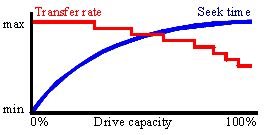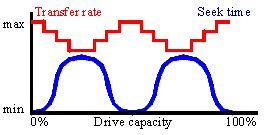The Storage Guide
Vertical Mapping
Traditional harddisks orders their capacity in 'vertical' mapping. The data is read/written from one cylinder first, starting at the top track down to the bottom, before the heads are moved to the next cylinder.
Horizontal Mapping
The 'horizontal' mapping. The data is read/written starting from the outer cylinder to the inner cylinder, before switching the heads to the next track.
Vertical and Horizontal Mapping Combined
Some harddisks use a combination of 'vertical' and 'horizontal' mapping.
As you can see in the above pictures, transfer rate is higher when data is read or written to the outer parts of a disk. The reason is that there is more space for sectors. The number of sectors varies in steps. Usually on a disk there are 10 to 20 zones (called 'notches') with a constant sector number. That' the reason why you see the steps in the transfer rates.
Some harddisk use the combination of 'vertical' and 'horizontal' mapping. The 'horizontal' mapping is used in the zones, the 'vertical' mapping between the zones. However, transfer rate and seek time look the same to 'vertical' mapping.
If you are going to buy a HD you have may need to know what kind of mapping the drive does. If you need constant transfer rates (for video, audio) you should get a drive which doesn't do the horizontal mapping. However, drives with horizontal mapping are not very common.
Get Tom's Hardware's best news and in-depth reviews, straight to your inbox.




